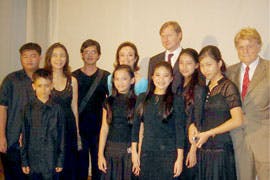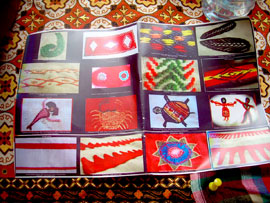Blending culture and business in Iloilo
Jan 21, 2015
Story



Published at The News Today Philippines on May 6, 2008
Blending culture and business in Iloilo
By Rhea B. Peñaflor
The city is built to music, therefore never built at all, and therefore built forever.
~Alfred Lord Tennyson
The Iloilo Youth Orchestra
Iloilo City with its goal to become a Premier City in 2015, is slowly getting there. Music and the arts play a vital role in promoting a strong economy not only for tourists but they have also become a dependable source of livelihood for the locals. That is why it is worthy to note the creation of the Iloilo Youth Orchestra (IYO) – not only reviving the city’s local musical heritage, but also making Iloilo City a place worth visiting because of its interesting, rich culture through its thriving music and diverse arts, thus, in effect contributing to economic promotion. Indeed, a place with a good culture means that there is always a good business opportunity.
During the 1950s, there were active orchestras in Iloilo City, according to composer-conductor Romulo Pangan. Music was played almost everywhere in Jaro public plaza’s Graciano Lopez Jaena Park and in schools which have their own orchestras, like the Colegio del Sagrado Corazon de Jesus, the St. Vincent Ferrer Seminary and the Central Philippine University (CPU). There was also the Iloilo Municipal Band, which was later known as the Iloilo Symphony Orchestra, and which had its last major performance during the inauguration of the Philippine National Bank (PNB) at Gen. Luna Street. The Iloilo Symphony Orchestra was composed of seasoned players, mostly military men, but soon some of them sought greener pastures in Manila and abroad, while others chose their regular, stable non-music professions.
It was during the Martial Law regime when orchestras in Iloilo City started vanishing for many musicians opted to migrate abroad because of the country’s political instability. Pangan recalls that there was promise for musicians in Manila and other parts of the world, but certainly not in Iloilo City when the local authorities were no longer supportive of the performing arts.
At that time, the Ilonggos did appreciate classical music, but there were just no qualified musical instructors left to teach those who were interested in playing orchestral instruments. Pangan said thatthe salary for a music teacher was not enough to sustain a family’s basic needs, unless he or she had other part-time jobs.
At present, schools make music a part of their curriculum but this is not enough training to those who are very much interested with fully developing their musical skills. YAMAHA School of Music, for example provides one-on-one training lessons for organ, piano, violin, acoustics and electric guitars, and drums. Also, this is where a training school for music outside a real academic school has become popular as a result of the growing number of those who want to thoroughly learn music. Hence, there is an increase in the demand for music instructors in training schools.
Furthermore, music became a separate focus of interest from the academic subjects, which a student used to just study within the four walls of an educational institution like a school or a university. Tuition fees in these training schools though can be more expensive than that of regular schools but they still have a flourishing market not only because of the musical skills which students may formally develop during the trainings but it can also be a promising profession in Iloilo City.
Thus, the Iloilo Youth Orchestra , a community-based organization became an alternative to those who want to extensively study orchestral instruments.
It was in 2007 when the Iloilo Youth Orchestra came into existence, providing training sessions to those who are interested to be a part of an orchestra.
A year before the IYO was officially incorporated, it already participated in a major production, an opera for children entitled “Mozart’s Magic Fantasy – A Journey through the Magic Flute.” This opera was officially endorsed and financially sponsored in part by the Austrian Embassy in the Philippines. Mozart’s Magic Fantasy was shown from November 25-30, 2006, at the St. Anne’s Hall, Assumption School, Iloilo City.
IYO is a non-stock, non-profit organization duly registered at the Securities and Exchange Commission (SEC) on January 3, 2007.It has the mission of training and developing local musicians, creating performance opportunities for musical artists, promoting collaboration with local artists and encouraging the involvement and support of the local community in the artistic endeavors of the organization.
IYO trainees, from 3-years-old and above, have performed a diverse repertoire of folk, popular and classical music including works of J.S. Bach and Antonio Vivaldi, among others.
In 2007, IYO had a total of nine performances in different venues, varying from schools, concert halls, malls and restaurants. Recently, the organization has been invited to guest perform on Jamie Rivera’s Concert this upcoming March 29, 2008 at Sarabia Manor Hotel, Iloilo City. The concert’s proceeds will go to Museo Iloilo and Philippine Academy of Ophthalmology (PAO-LCSP) for Guimaras and Iloilo.
Indeed, this newly-founded organization has accomplished so much in its first year.
The Ilonggo business community welcomes the IYO. Having an existing orchestra in the city is one sure way to attract tourists and investors.Through showcasing what great talents the Ilonggos have in music and the arts, cultural tourism is, thus, promoted.
This is good for the local economy as cultural tourism such as the creation of IYO for example, creates jobs for the local artists, provides revenue for the local concert venues, hotels and restaurants, etc. and promotes local artistry through tourism. Any form of tourism has a ripple effect as tourists would not only buy tickets to cultural events, stay in local forms of lodging, and eat out but they will eventually have to spend on travel (taxis, bus, boat, plane, jeepney, etc), go shopping for themselves and buy souvenirs, etc.
However, IYO President Melissa Exmundo emphasized that for any orchestra to develop and expand, funds are needed. At present, IYO is only offering violin training. More funding is required to acquire the more expensive instruments such as the cello, doublebass, woodwinds and brass. As the cost of these instruments are quite prohibitive for the average student, IYO would need to equip itself either by purchase or donation. The acquisition of these instruments will certainly help in expanding the organization’s training offerings. Once the instruments are available, qualified instructorswould be sought but as Iloilo City is very much lacking in the latter, they would have to be brought in from Cebu, Manila or even abroad.
The organization would appreciate donations, grants or funding of any kind for the expansion and development of the orchestra.
Without a doubt, there is always a synergy between music and the arts on the one hand, and good business on the other hand.When they go together, it could only mean a great city with a robust economy.And Iloilo City is headed that way.
For inquiries, grants, donations and sponsorships, please contact IYO at wireless land phone number (033)3… ; mobile number 0928-667-7638 or email at iloilo_youth_orchestra@yahoo.com
Iloilo’s Indigenous People
Among Iloilo’s priceless treasures are its indigenous people. Gawad Manlilikha ng Bayan (GAMABA) awardee Federico Caballero was guest during the highlight of Iloilo City’s 1st Investment Forum, which centered on the launching of the coffeetable book entitled “ILOILO: A RICH AND NOBLE LAND.”
Caballero is also a Panay Bukidnon epic chanter.
Panay Bukidnon is a collective name that means “people of the mountains of Panay.” It was coined by Dr. Alicia P. Magos, anthropologist and National Commission on Indigenous People (NCIP) cultural consultant, for these people, whether they are Pan-ayanon, Halawudnon, Akeanon or Iraynon.
They got their names based on where their nearest source of water is – e.g., Pan-ayanon (people near the Pan-ay river). Also, some groups have been named according to the source or direction of the river flow – e.g., Halawudnon (near the head waters) or Iraynon (near the delta).
The Panay Bukidnon are a people of great talent. They chant, dance the Binanog (hawk-eagle dance), embroider and play various musical instruments. However, because of various influences from so many agents of change (mass media, government and non-government organizations, urban lifestyles, etc.), the younger generation began to lose interest in practicing their traditions.
Seeing the eventual possible demise of the Panay Bukidnon culture, Magos established the project Balay Turun-an (School for Living Tradition). In August 2001, she spearheaded this project with the support of the National Commission for Culture and Arts (NCCA), the National Commission on Indigenous People (NCIP), the UP Center for West Visayan Studies and the Municipality of Calinog.
Undeniably, Iloilo’s rich cultural heritage through recognizing and appreciating its indigenous people helps promote an economically solid and successful city.
Antique’s Kiniray-a Festival
The Kiniray-a Festival of the Province of Antique features literary, musical and artistic cultures and the food of the Kiniray-a-speaking people.
Last year, my friend, Melissa Exmundo, invited me to go with her to San Jose, Antique, for the 1st Kiniray-a Festival. I then thought to myself that it was high time to go back to my roots, since my mother is from Antique.
As a child, I was always fascinated by my grandmother’s stories about the supernatural beings and the babaylans (medicine men or women).I liked mystical stories.No, I love all her stories.My grandmother was a surwana, an herbal healer, during her time and she lived with us until she passed away.I always looked forward to her new stories and I always wanted to hear her delightful chants of asking San Rafael to make the rain stop.I found her stories surreal and interesting.I believe that these stories may have been epics, not only during her time, but that they were passed on from generation to generation.I can still recall her saving 12 kinds of seeds and giving rituals to each one right before the New Year, because she said that would give abundance and protection to the family.
Going back to the 1st Kiniray-a Festival, the Panay Bukidnon were guests. However, among the many cultures that the Panay Bukidnon presented, I knew that Exmundo’s interest centered on their traditional hand embroidery tradition called Panubok.This also enticed me, not only because I have seen their commissioned works, but because I had been stunned by the very clear details of their craftsmanship.
Panubok is the Panay Bukidnon’s traditional hand embroidery. The colors the Panay Bukidnon use in Panubok are amazing, having the vibrant, ever-powerful red as its dominant color.My eyes sometimes seem to deceive me but these hand embroideries are, to me, all beautiful creations, masterpieces of the indigenous people, our indigenous people, whose ingenuity is truly beyond compare. It was truly unbelievable to see the Panay Bukidnon’s magnificent Panubok.
Dibuho refers to the traditional embroidery designs used as guides in Panubok. The Panubok consists of myriad dibuho. These designs are taken from what the Panay Bukidnon see in their surroundings, their environment.The designs include natural and organic forms derived from the shapes and colors of flowers (e.g., bulak ka labog, bulak ka alayaw), snakes (mata ka magkal, sudlikama), wild ferns (pako-pako), vines (binalago, tugi-tugi), and birds (matang punay), among others.
That is the reason you would see so much from nature – from flowers, snakes, wild ferns, tigila (a kind of plant pest), tugi-tugi (a kind of vine), leaves of the tugi-tugi and tendrils of wild vine.
Tubok refers to the Panay Bukidnon’s embroidery as a craft, and it was an endangered practice until the rise of Balay Turun-an.
Before 2001, Magos said that Tubok was, indeed, an endangered practice, because the academe did not formally recognize then that there still exists this indigenous group which is popularly known as Sulod.
Ethnomusicologist Maria Christine Muyco, a U.P.-Diliman doctorate candidate in Philippine Studies, has immersed herself in fieldwork with the Panay Bukidnon.She started fieldwork in 2001, but it was between June 2003 and May 2004 when she had a straight year of intensive fieldwork to learn about their dances and musical instruments, and along with these, how to tubok. She has lived with the Panay Bukidnon and has learned that, from their traditional attire to their dances, everything is an integration of their way of life, their culture and their heritage as indigenous people.
Muyco said the elders are gifted on how to tubok and she certainly does not want that this would be lost because this is a very rich heritage which should be kept and revived. In 2005, Exmundo suggested to her that one effective way of promoting the art of traditional hand embroidery would be through an exhibit and a competition.With the help of Magos and the Municipality of Tapaz , Capiz, Exmundo’s idea was realized on August 5, 2006, at the Tapaz Civic Center, Tapaz, Capiz, where a Panubok Fest – a competition for the Koton (embroidery inside the blouse) used for Binanog dancing was held.There were also exhibits for the Panay Bukidnon’s different traditional wears.
On December 8, 2007, the Municipality of Calinog, Iloilo, in cooperation with the NCIP, held a Workshop of Panubok for Children during the Trade Fair in the plaza of Calinog. This was in preparation for the proposed 2nd Panubok Contest, which is tentatively scheduled on April 2008, in Calinog. This contest shall be open to the hantup (skillful embroiderers) of every barangay in the Panay highlands, such as the barangays of Tapaz, Capiz – Siya, Tacayan, Nayawan, Taganhin, Bato-Bato and Rizal Sur – and the Calinog barangays of Garangan, Agcalaga and Masaroy.
The participants in the 1st Panubok Workshop were from the barangays of Nayawan (Divine Arbis, Lovely Perillo, Rosalie Glimer and Maylen Catamin), Siya (Anabel Castor, Alfred Moneteverde, Jan Rey Castor and Reden Jimenez), Agcalaga (Jolie May Lastrilla, April Rose Lastrilla and Sharon Carado), and Garangan (Angily Gilbaliga and Chenchie Fernandez.)
Indeed, Magos, Muyco and Exmundo have been instruments in bringing back to life the very strong customs and traditions of the Panay Bukidnon. Magos’s expertise is on epic chanting, while Muyco’s concentration is on the Binanog dance and traditional instruments since these are her focus of study.Exmundo, on the other hand, as I have shown, is very enamored with the art of traditional hand embroidery.The three women’s simple yet sincere passion for what they believe in and appreciate as part of our cultural heritage as a people, is noteworthy.
Local artist Alan Cabalfin has been very supportive, too, and has even dressed dolls with the advocacy of protecting women’s rights. This project has already begun in Manila with the initiative of art activist Norma Liongoren.
I, for one, am glad to have known the many unique capabilities and knowledge of the Panay Bukidnon from the activities which I witnessed and participated, both in San Jose, Antique, and Calinog.I am a layman and I suppose that there are lots of laymen who are as interested as I am with our indigenous people.
Quoting Magos, “The idea of reviving the Panay Bukidnon’s customs and traditions is to ensure the perpetuation and continuation of their very rich heritage, especially the Tubok craft.This is also a way of encouraging them to go on with their craft and be skillful and proud of their heritage and, of course, this is one big way to give them a kind of livelihood which is closest to their hearts.”
Balay Patawili
A part of Muyco’s dissertation is a feasibility study on the Balay Patawili, a production house where the Panay Bukidnon would do their Panubok.According to her feasibility study, this production house would support the Balay Turun-an of the Panay Bukidnon.
She is most thankful that the Panay Bukidnon are also very responsive to the projects, contests and workshops which have been done for them.She maintains that these activities will pave the way toward the vision of a self-sustainable community which possesses utmost control and ways of managing changes brought about by various impinging local and global forces.
Indeed, preserving a culture is not just a one-man job, or one-woman job for that matter. Everybody has a role – businessmen, students, and even simple citizens, because this is not only an important part of our heritage, but of our cultural tourism, as well.
(This is a reprint of the articles in Consumers and Business Forum magazine, Volume 4 Issue 1, 2008.)
Author’s note:
The proposed Panubok 2 was pushed through on April 25, 2008 at the Calinog Public Gym.




